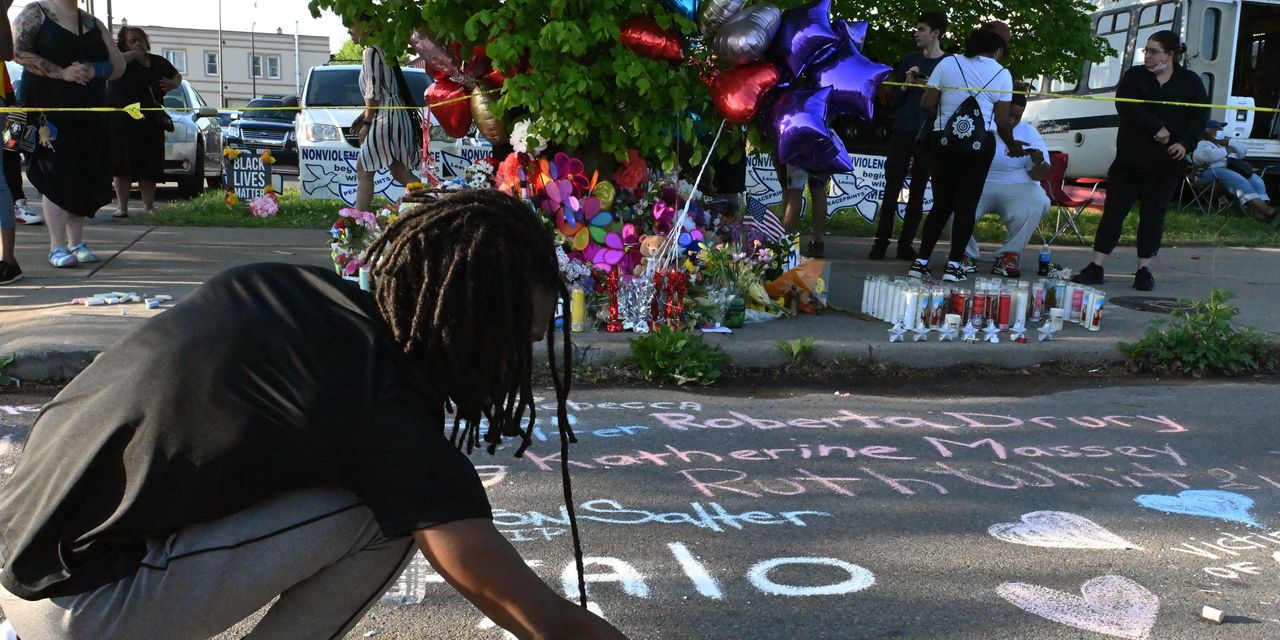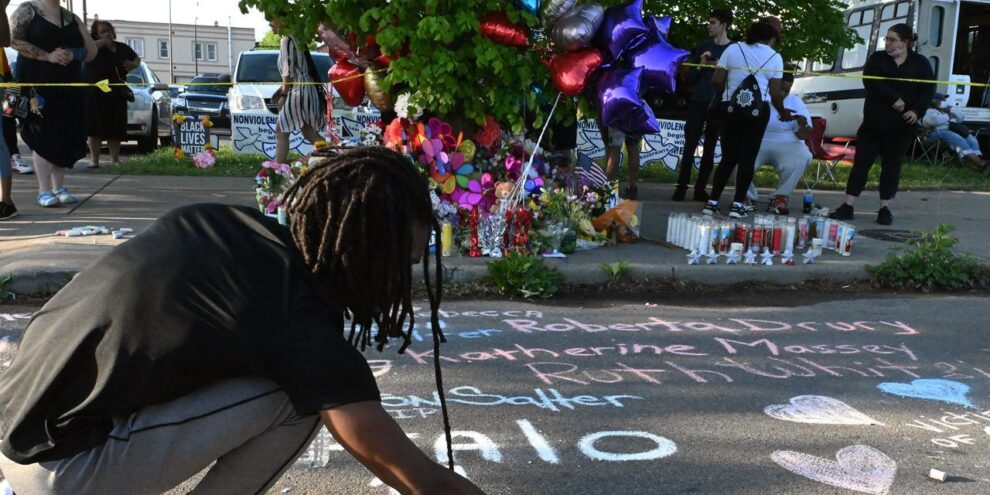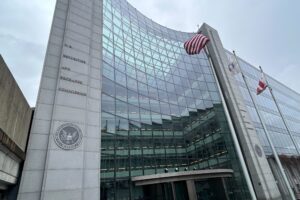
Long before a white gunman allegedly stormed a grocery store in a majority-Black Buffalo neighborhood, killing 10 people, the city bore all the harrowing scars of racial inequality: segregated neighborhoods and concentrated poverty, a yawning gap between Black and white homeownership, a lack of grocery stores in communities of color, and disparate health outcomes.
That segregation is part of what drew the suspected gunman to Buffalo Saturday afternoon, when he allegedly targeted Buffalo’s East Side and Tops Friendly Market because of the predominantly Black population living nearby. New York Gov. Kathy Hochul told CNN that investigators believe the gunman targeted the surrounding ZIP code because it had the highest concentration of African Americans within hours of his home in Conklin, as well as a business that was one of the busiest in the area. The suspect allegedly said in online messages reviewed by the Washington Post that he’d visited the store back in March, observing “many Blacks” inside.
The alleged gunman, who had allegedly endorsed the racist “great replacement” theory, had planned to shoot even more Black people upon escaping the store, according to local authorities, but surrendered once outside. He’s since pleaded not guilty to charges of first-degree murder. Those killed in Saturday’s shooting included a father who was picking up a surprise birthday cake, a local civil-rights advocate, a retired police officer working as a security guard, and an 86-year-old who had just finished visiting her husband of 68 years at a nearby nursing home. All of the 10 people killed were Black.
“Redlining was used as an excuse to deny Black people access to loans, keeping them in neighborhoods with lower property values and little investment. White neighborhoods, meanwhile, were seen as more desirable and worthy of development.”
President Joe Biden called the massacre an act of terrorism.
“These actions we’ve seen in these hate-filled attacks represent the views of a hate-filled minority,” Biden said during remarks in Buffalo on Tuesday. “We can’t allow them to distort America — the real America. We can’t allow them to destroy the soul of the nation.”
But segregation and economic inequality are also aided by America’s policymakers, and a fact of life that people in Buffalo have been living with for generations. A 1990 study on the state of Black Buffalo led by Henry Louis Taylor Jr., the director of the Center for Urban Studies at the University at Buffalo School of Architecture and Planning, unearthed high unemployment, high poverty rates, and segregation on the city’s East Side. A 2021 study meant to examine three decades of progress for the city’s Black residents found more of the same.
“The changes in their lives over the past 31 years have been modest,” the study said. “During this period, an entire generation saw little if any improvements in their lives.”
“Redlining was used as an excuse to deny Black people access to loans, keeping them in neighborhoods with lower property values and little investment. White neighborhoods, meanwhile, were seen as more desirable and worthy of development.”
It used to be that Black and white workers in Buffalo shared the same residential spaces, even residing in boarding houses together, Taylor told MarketWatch. That changed with the rise of homeownership in the middle of the last century. Redlining was used as an excuse to deny Black people access to loans, keeping them in neighborhoods with lower property values and little investment. White neighborhoods, meanwhile, were seen as more desirable and worthy of development.
One neighborhood close to where the shooting occurred, Cold Springs, was once also described as undesirable for mortgage lending due to the “infiltration” of Black people, according to reporting from WKBW, an ABC affiliate in Buffalo, and maps created by the Home Owners’ Loan Corporation. The color-coded maps entrenched segregation, made it so that Black people could not afford to become homeowners, constrained wealth creation, and subjected them to a more predatory rental market, Taylor said.
“In the formula that Buffalo used — and every city uses it — as value increases in a neighborhood and a community, it becomes the node around which other aspects of neighborhood development occur,” Taylor said. “In the highest-value neighborhoods, you’re going to have the best institutions, services, amenities. The lower the value in the neighborhood, the more you will see less of that happen.”
“The color-coded maps in certain areas entrenched segregation, made it so that Black people could not afford to become homeowners, constrained wealth creation, and subjected them to a more predatory rental market. ”
But even as Black people were sorted into under-invested communities by policy design, not by choice, racists blamed them for the poor outcomes in the neighborhoods in which they lived. Today, residents in the East Side of Buffalo — which was further degraded by the construction of the Kensington Expressway in the ’50s and ’60s — experience higher hospital admissions, a lack of access to healthy, affordable food and a lower life expectancy.
“They see white neighborhoods and the quality of white neighborhoods as the work of white people,” Taylor said. “Then they say, ‘Those neighborhoods over there used to be great when white people lived in them, but when white people left and Black people moved in they messed them up.’ That’s the type of racist type of thinking that occurs.”
Add that to the belief that people of color are somehow taking jobs away from white people.
“I mean, it’s a kind of contradictory view that doesn’t make sense,” Taylor said. “The reason I think that they believe that is that there’s this association that exists between anti-critical race theory groups, the efforts to suppress the Black voters, and the rhetoric that comes from the Republican party. They feed these individuals.”
“The ‘great replacement’ theory stems from the false idea that a cabal of elites is conspiring to undermine, if not eliminate, white people via immigration policies. talking points echoed by some Republican lawmakers, candidates, and conservative commentators.”
The “great replacement” theory the gunman allegedly espoused stems from the false idea that a cabal of elites is conspiring to undermine, if not eliminate, white people via immigration policies.
Similar talking points have been echoed by some Republican lawmakers, candidates, and conservative commentators who are now drawing scrutiny over their claims that Democrats want to increase immigration to shift voter demographics in their favor. About one in three adults similarly believe there’s some effort afoot to replace U.S. citizens with immigrants for political reasons, according to an Associated Press-NORC Center for Public Affairs Research poll.
To be sure, Republicans have pushed back on assertions that their rhetoric could be somehow linked to the Buffalo shooter’s motivations, according to the New York Times. Wyoming Republican Rep. Liz Cheney, however, wrote on Twitter TWTR, +1.19% that “the House GOP leadership has enabled white nationalism, white supremacy, and anti-semitism.”
“It wasn’t some kid just hating Black people arbitrarily,” Taylor said. “He saw himself as tied to a larger movement.”
In the aftermath of the shooting, some residents have been clear in saying they don’t just want political statements condemning the shooting and racism that allegedly motivated it — they want real, structural change, too.
“I could care less about what Biden said, I want to see action,” Toni Arrington, a hair stylist who was outside the Buffalo community center where Biden spoke Tuesday, told The New York Times. “I want to see our community actually get help. I want to see people actually be protected. We work, we pay taxes, we pay for our protection and we’re not getting it.”
Local racial justice activist Myles Carter similarly told local public radio station WRVO that “all these people coming from outside the community to speak on the people that died here, that were murdered here, I don’t think is appropriate when they haven’t been fighting for the for the Black lives that are still living, or doing what we needed from them to keep us from being in these in these bad situations.”
Anna Blatto, a research associate for the Partnership for the Public Good, a community-based think tank in Buffalo, said that it’s critical to hear people living closest to the problem about their needs.
“The policy recommendation really is: Bring people from those communities together, listen to Black voices, listen to the voices of folks who live in those communities, because they know their communities needs, they know where investment is going to be most helpful,” Blatto said.



